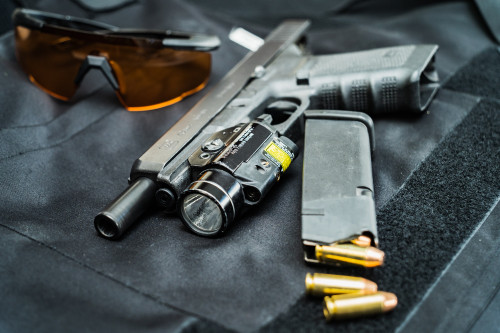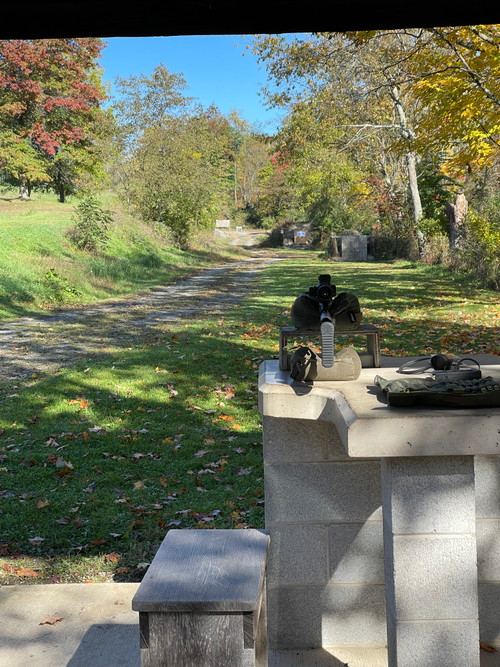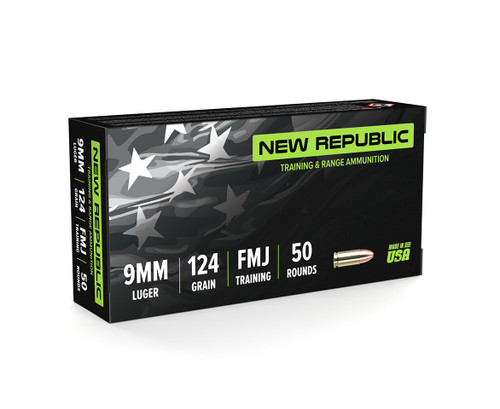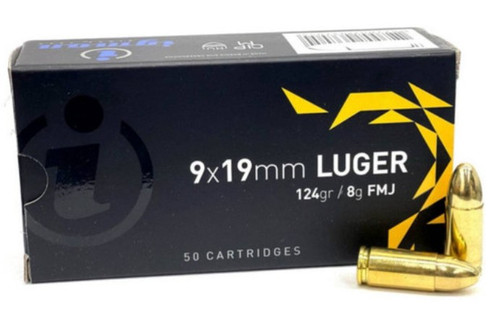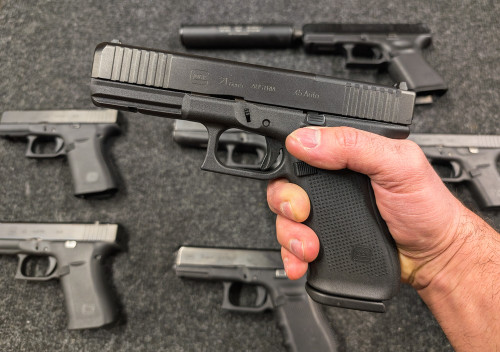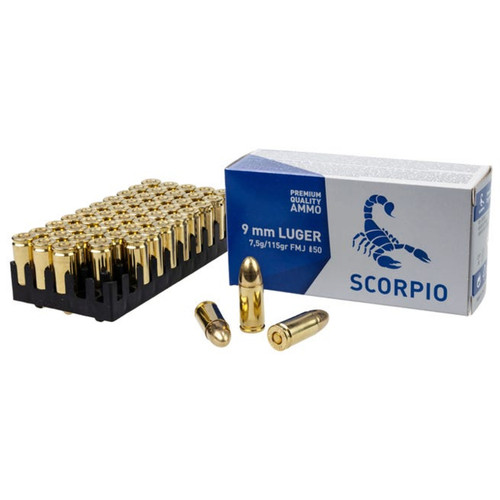In movies, operating a firearm often looks as simple as point and shoot. But anyone who’s actually spent time around guns knows it’s not that easy. Lining up an accurate shot takes effort, skill, and the right equipment.
Sure, you can do it with iron sights, but it doesn’t make you any cooler. In many cases (especially at longer ranges), shooting with iron sights may be damn near impossible. Plus it makes target acquisition and engagement more difficult in high-stress scenarios.
That’s why gun optics exist — to make aiming a firearm easier.
Optics can be mounted to handguns, rifles, shotguns, PCCs, or just about anything else that shoots. The extra magnification and precision reticle has huge implications on many different aspects of shooting, from target acquisition to follow-up shots. Because of this, optics also play a role in many different shooting scenarios including law enforcement, hunting, home defense, and competition.
While optics are definitely useful, they also complicate the task of shooting — and choosing the right optic. If you’re new to optics, your eyes may glaze over at terms like reticle, magnification, minute of angle, field of view, or aiming point. That’s okay. We’re here to clear up all of that. However, even if you understand the basics, there’s more to discover about optics than you may have realized.
What Is a Gun Optic?
While we may think of the optic as a relatively new invention, the ancient Egyptians actually used translucent rocks to bend light around 800 BC. Fast forward 400 years, and the ancient Greeks used magnifying glasses to make small objects appear bigger — the same science used in optical sights today.
Modern gun sights are specialized versions of these primitive lenses. Furthermore, firearm optics are often designed to accomplish specific tasks. For example, some optics can make it easier to aim in low-light conditions. Others feature high levels of magnification to improve long-distance shooting. In fact, if you’re going for long-range precision, some kind of magnifying optic is essential.
However, optics aren’t limited to distance shooting. Even if you’re shooting at targets within 100 yards, optics can still help you engage targets more effectively.
In general, the structure of an optic consists of these parts:
- Lens: Collects light into an image that feeds into your eye.
- Tube: The housing of the optic. Some optics use rings that wrap around the tube to mount to a gun.
- Turret: Some optics feature turrets, which hold knobs to adjust for windage and elevation.
- Reticle/Dot: All optics have an image that designates their point of aim. For red dots, this is a single point. Prisms, holographic sights, and rifle sights will have a reticle that gives a shooter data, like how far a bullet will drop over a certain distance or where to position your crosshairs to compensate for wind.
Optic Terminology
Before we look at different types of gun optics, let’s clear up a few key terms:
- Magnification: How much closer an optic makes your target appear, counted as a whole number. For example, a “2x” scope makes your target appear two times closer.
- Point of Aim: Where you’re currently trying to make the bullet go. For example, the red point on a red dot sight. Your point of aim will change depending on your distance from the target.
- Minute of Angle (MOA): A gauge of angular change, measured in degrees. This essentially measures how the travel of a bullet changes over distance. For example, 1 MOA is ~1.05 inches at 100 yards, 2.1 inches at 200 yards, and so on. Some optics feature a ring around the point of aim (measured in MOAs) to help acquire targets.
- Milliradians: Literally “one thousandth of a radian,” milliradian is another common measurement for gun optics (similar to MOA), often abbreviated as “MIL” or “MRAD.” This system divides the circular shape of your scope into 6.28 equally sized sections (each 57.3 degrees), together measuring 1 radian. 1 MIL translates to ~3.6 inches at 100 yards.
- Field of View: Everything you can see while shooting. Some optics, like red dots, prisms, and holographic sights, allow you to aim with two eyes opened, giving you a larger field of view.
- Sight Picture: The part of your field of view that you see through the lens of your optic.
The Diverse Landscape of Gun Optics
If you only remember one thing about optics, remember this. There’s no “do-it-all” optic. Instead, you’ll choose an optic based on your individual needs. Below, we’ll break down some of the pros and cons of the most common gun sights you’ll find on the market.
Iron Sights
Iron sights are the “old school” way to aim. For hundreds of years, iron sights were the only way to aim a firearm, which is why most firearms feature them. They’re harder to aim with than any optical sight, but will never let you down at closer ranges, should you need them. If you break your iron sights, chances are you have bigger problems.
Irons are especially difficult to aim in low light conditions. However, they can’t run out of batteries like some optics, another factor that makes irons a great backup. You can also use irons with two eyes opened for improved situational awareness, but it’s generally easier to do it with one eye closed.
One big drawback of iron sights (that other types of sights eliminate) is the sight radius. This is the distance between a rear and front sight, and it can seriously impact how easy it is to aim your irons. A longer sight radius makes it easier to aim, while a shorter one makes aiming more difficult. Reflex optics, like red dots, prisms, and holographic sights, eliminate this problem by having effectively infinite sight radius.
Red Dot Sights
Red dot sights were one of the first close-range types of optics to hit the scene. Industry titans Aimpoint first introduced red dots in the 70s, but they didn’t become popular until the 2000s.
With a red dot, an LED emitter shoots a beam of red light into a lens. Then, the lens superimposes the red dot over your field of vision, designating your point of aim. Red dots are great for short-range shooting. They generally have zero magnification, but you can pair them with a separate magnifier to get 2x, 3x, or even 5x magnification.
Red dots are usually fairly small and lightweight, making them a favorite of anyone who needs to shoot close-range. One of the biggest advantages of red dots is that you can use them with two eyes open for increased situational awareness. What’s more, they effectively have infinite eye relief.
One of the only drawbacks to red dots is that they can be difficult to use if you have an eye condition called astigmatism. This condition causes light sources to appear blurry, and it’ll make the red dot in the middle of your sight picture more of a red blob.
Finally, some shooters use a small red dot (like one designed for a pistol) as their backup sights instead of irons. Some larger scopes will actually feature a dedicated mount for a secondary red dot. In addition, some scope mounts allow a shooter to offset their red dot, attaching it to the gun at an angle instead of directly above the bore.
| Pros | Cons |
|---|---|
| Fast target acquisition | Difficult to use if you have astigmatism |
| Long battery life (up to 50,000 hours in some cases) | Fairly basic reticle (just a dot or ring) |
| Effectively infinite eye relief | |
| Can be used with two eyes opened for increased situational awareness |
If you’re interested in picking up a red dot, check out the HS510C and HS403, both by Holosun.
Prism Sights
Prism sights are another close-range option. These hit the scene before red dots or holographic sights became mainstream. For an example of a sturdy, reliable prism sight, look no further than the notorious ACOG.
The Trijicon ACOG really is the pinnacle of prism optics these days. It boasts a ton of features to choose from like battery-less illumination, fixed zoom settings, and different heights over bore to accommodate varying firearm platforms. Its reticle offers great options like bullet drop compensation, and its glass clarity is second to none.
At first glance, prism and red dot sights appear pretty similar. They’re both small, compact, low-magnification optics that allow a shooter to keep both eyes opened. Prisms may offer a fixed zoom option (usually no more than 5x), but many only offer 1x magnification.
However, that’s where the similarities end. One of the biggest differences between a red dot and a prism optic is that a prism has a reticle etched into its glass. These reticles relay more information to a shooter than a red dot would, including bullet drop compensation. Prism sights usually feature some way to illuminate this reticle, making it easier to see in high- or low-light conditions.
| Pros | Cons |
|---|---|
| Fast target acquisition | Heavier than a red dot or holographic sight |
| Can be used with two eyes opened for increased situational awareness | Less eye relief than red dots |
| No issues for people with astigmatism | |
| More advanced reticle than red dot |
Holographic Sights
Holographic sights are some of the most popular close-range optics out there. Chances are, you’re familiar with at least one kind of holographic sight: the Eotech. As one of the primary optics of the US armed forces, anyone who’s a military game or movie buff will recognize the Eotech. This holographic sight is literally bomb-proof and will last forever, making it the only sight you’ll ever need for most scenarios.
A holographic sight has a lot in common with a red dot. For one, they’re both used for close-range aiming. They’re also both fairly small and lightweight. The main difference is how they each work.
Holographic sights superimpose a hologram of an image over a lens, which then feeds the image into your eye. As a result, you’re not technically looking at a picture of the target, but you won’t be able to tell the difference. Like red dots and prisms, you can use a holographic sight with one or two eyes open.
| Pros | Cons |
|---|---|
| Fast target acquisition | More expensive than a red dot |
| Can be used with two eyes opened for increased situational awareness | Short battery life (about 500 hours) |
Telescopic Sights (Rifle Scopes)
If you really want to reach out and touch your target, telescopic rifle scopes are the way to go. These optics are the heaviest and most complex of these options. However, they also provide a shooter with the most flexibility.
In contrast to the other sights mentioned here, telescopic sights have multiple magnification levels, so you can use these sights to zoom. They’re most often used with long-range shooting or hunting, where you need to acquire a target, then zoom in to see it in better detail to pick a more specific point of aim.
Telescopic sights fall into one of two general categories: short- to medium-range and medium-to long-range. The first category consists mostly of Low Powered Variable Optics, or LPVOs. These usually have a 1x-4x or 1x-8x magnification. These types of optics have become more popular in recent years, and certain branches of the military (like the Marines) are already phasing out other types of gun sights in favor of LPVOs.
More powerful optics can reach up to 60x zoom, which is generally overkill unless you’re sitting at a bench and shooting extremely long distances. In fact, the higher an optic’s magnification level, the more difficult it is to acquire a target. For most long-range applications (like hunting or competitive shooting), a 3x-18x scope will work just fine.
| Pros | Cons |
|---|---|
| Variable zoom levels | Can be difficult to use for close-up shots |
| Most magnification out of all types of scopes | Need one eye closed to aim |
| Make long-distance shooting easier (and in some instances, make impossible shots possible) | Usually expensive |
Specialty Sights
Some optics fall outside of the previous five categories. For example, some optics provide night vision or thermal imaging capabilities. These are particularly niche (and therefore quite expensive) products. You may want a thermal optic if you’re hunting hogs in dense brush. Night vision optics are a great choice for anyone shooting in the dark or hunting nocturnal animals.
That said, some holographic, red dot, or reflex sights aren’t compatible with other night vision equipment. Make sure your optic has “night vision settings” if you need this compatibility. The optic’s manual will tell you what settings to use for night vision.
Making an Informed Choice: Selecting the Right Optic
With so many types of optics available, you’re probably feeling overwhelmed by the choices. Fortunately, picking the right optic doesn’t have to be difficult. You just have to pick your optic based on what you’re trying to accomplish.
- Short range: Red dot, holographic, prism, irons. Allow for quick target acquisition and aiming, critical for close-up engagements.
- Long range/precision: Telescopic or specialty. More difficult to acquire a target, but easier to make accurate long-distance shots.
- What you should always have as a backup: Secondary red dot (like a pistol red dot offset from your main optic) or irons.
If you’re on a budget, price will matter, too. There’s an adage that says an optic should cost at least as much as your gun, but that’s not always necessary. If price is an issue for you, go to a local gun shop and physically look through the glass of some of the optics. Reading about functionality will only do so much — to get an accurate representation of a sight picture, you’ll need to look through the optic yourself.
Final Thoughts: Understanding Gun Optics for Effective Use
Understanding gun optics is pretty simple if you remember that your objectives dictate your gear. If you need to reach out and touch a single target that’s 1,000 yards away, you'll want something with a high level of magnification. In contrast, you might want an ACOG if you need to quickly acquire/engage multiple targets at relatively close range.
Whichever optics you end up choosing, they’re not going to work straight out of the box. Instead, you’ll need to put in some range time zeroing your optic to get the crosshair on target.
Ready to take the plunge into the world of optics? Need a better optic to improve your shooting accuracy? At Pro Armory, we’ve got you covered. Check out our deals on firearm optics and tactical gear — all shipped directly to you for the lowest price possible.






